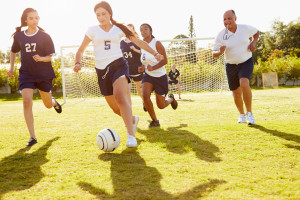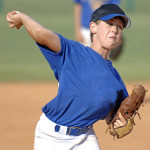 The words “You have an anterior cruciate ligament (ACL) injury” are ones that no athlete wants to hear, but it does happen.
The words “You have an anterior cruciate ligament (ACL) injury” are ones that no athlete wants to hear, but it does happen.
In fact, more than 200,000 ACL injuries take place in the United States every year.
The knee injury can occur during sports when an athlete makes contact with another player or in a non-contact situation by how they land from a jump or plant their foot.
Some athletes will hear or feel a popping sound in their knee and immediate symptoms include pain, swelling and not being able to walk.
Research shows that female athletes are also more likely to tear their ACL than a male.
“In the 12- to 18-year-old age category, some sources state that females are eight times more likely to tear their ACL than a male,” said Dr. Shelden Martin with OrthoArizona.
Martin said it also depends on the sport.
“The sports with the highest rate of ACL injuries for females are basketball and soccer.” Martin said. “We don’t have solid data to prove our suspicions, but intuitively we believe that there are a number of biological and anatomical factors that predispose females to having higher rates of ACL tears than males.”
One factor is that females have a wider pelvis than males.
“This creates a greater angle of the femur as it approaches the knee, creating an increased valgus alignment at the knee, or a more “knock-knee” alignment,” Martin said. “We know the greater the valgus angle, the greater the risk for an ACL injury.”
The second factor is the width of the gap inside the knee between the two ends of the femur bone called the condyles. This gap, called the intercondylar notch, where the ACL ligament travels, tends to be narrower in females and could cause impingement on the ligament during extremes of motion, leading to injury.
“The intercondylar notch is seen to be quite narrow in many female patients at the time of ACL reconstruction surgery,” Martin said. “One of the important steps of the surgery is to widen this notch prior to passing the graft to allow appropriate space for the graft.”
Martin said females have hormonal factors that can contribute to ACL injury.
“Estrogen causes ligament laxity, or relaxation, and females have higher estrogen levels than males,” Martin said. “If they have more ligamentous laxity, they’re going to be more prone to tearing their ACL.”
Additionally, females also tend to have weaker hamstrings and hip abductors compared to males, which can lead to improper landing technique when striking the ground landing from a jump. This can place the knee in a more vulnerable position for an ACL injury.
The recovery time for this type of injury is different for every patient. It can be anywhere from six months to a year.
“The return to play rate, depending on the study you read, is somewhere in the range of 75 to 95 percent,” Martin said. “We have a high rate of getting these athletes back, but we still have significant room for improvement.”
So how can we prevent ACL injuries?
Martin believes females and males potentially can decrease their risk for an ACL injury by proper training, using certain exercises to help keep their muscles strong around the knees, thighs and hips.
“As athletes continue to become stronger and faster with more advanced training techniques, we continue to see increasing rates of ACL injuries,” Martin said. “It’s, therefore, critical that athletes at all levels implement specific exercises and training techniques into their preseason and offseason regimens to do all they can to decrease their risk of an ACL injury.”
The doctor has an ACL Injury Prevention Clinic he uses to teach young and professional athletes.
“We take these athletes through an educational session that gives them the basic information about the ACL and then teaches them training programs utilizing different types of preventive exercises,” Martin said.
While there is not enough data out there yet to determine if these ACL prevention techniques are working, Martin believes it’s still important to implement.
“I think the ACL Injury Prevention Clinic educates athletes about one of the most common and devastating injuries an athlete can sustain,” Martin said. “Our hope is that this clinic will give these athletes an awareness of this injury and tools to hopefully prevent an ACL injury.”
If interested in having Martin conduct an ACL Injury Prevention Clinic at your school or sports club organization, contact Dr. Martin.








